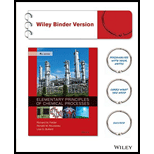
(a)
Interpretation:
The state of the reaction at the end of two-hour period is to be stated. Also, the percent decomposition of dimethyl ether is to be determined if the reaction has not proceeded to completion.
Concept introduction:
A flowchart is the complete representation of a process through boxes or other shapes which represents process units and arrows that represents the input and output of the process. The flowchart must be fully labelled to infer important data about the process involved.
Equation of states for an ideal gas is:
Here,
Stoichiometry is the calculation of the reactants and the products involved in aa chemical reaction. It is based on the law of mass conservation. According to the stoichiometry, total mass of the reactants equals the total mass of the products.
(b)
Interpretation:
The input-output enthalpy table is to be prepared and filled using elemental species as reference.
Concept introduction:
Specific heat capacity
Specific enthalpy
Here,
(c)
Interpretation:
The values of
Concept introduction:
The energy balance equation to be used is:
The formula to calculate the extent of reaction,
Here,
The formula to calculate heat of the reaction is:
The formula to calculate the internal energy of the reaction is:
(d)
Interpretation:
The amount heat transferred to or from the reactor during the two hours of the reaction is to be calculated.
Concept introduction:
The formula to calculate the value of
(e)
Interpretation:
The final volume of the reactor and the required amount of heat transfer are to be calculated is the reactor used is expandable. Also, the reason for the difference in the values of calculated
Concept introduction:
Equation of states for an ideal gas is:
Here,
For the system at constant pressure but variable volume, the mount of heat transfer is calculated as:
Want to see the full answer?
Check out a sample textbook solution
Chapter 9 Solutions
Elementary Principles of Chemical Processes, Binder Ready Version
- the answer is shown but i dont know how to get to itarrow_forward1. (20 points) Steam (6000 kg/h, 10 bar, 400°C) is passed through an adiabatic turbine that drives a shaft to generate power. The steam leaving the turbine is at 0.5 bar and passes to a chiller where heat is removed at the rate of 1.25 x 107 kJ/h. Saturated liquid leaves the chiller at 0.5 bar. (a) How much work (kW) is produced in the turbine? (b) What is the quality of steam leaving the turbine? Sometimes, steam produced is 'wet' in nature, and is composed of saturated water vapor and entrained water droplets. In such cases, quality is defined as the fraction of steam that is vapor.arrow_forwardWLV2 | Online teaching and × + w.com/ilrn/takeAssignment/takeCovalentActivity.do?locator-assignment-take A १ eq eq eq [Review Topics] [Referen Draw the structure of 3,3-dimethylbutanal in the window below. • In cases where there is more than one answer, just draw one. 985 + / $ Sn [ ] ChemDoodle ? req Submit Answer Retry Entire Group 8 more group attempts remaining req req Cengage Learning Cengage Technical Supportarrow_forward
- A flat-sheet membrane of thickness, L, and surface area, S, separates two fluids (see figure). The concentration on the upstream side is maintained at C_A0 while that on the downstream side is maintained at zero. The membrane is loaded with an immobilized enzyme that converts substrate A to product B according to a zero order reaction mechanism given by:R_A=-k_0"' (d) What is the flux, N_A, at the downstream surface (z=L)? (e) Under what condition will the flux at z=L be equal to zero? (f) At the condition in (e), what can you say about the diffusion time relative to the reaction time?arrow_forwardDevelop a purification train for a facility where first process is a perfusion upstream bioreactors 500L producing low cell culture titer of approx. 0.5 g/L perfusing at 2 VVD over 30 days. The current facility has a secondary clarification process for the perfusate coming from the bioreactor. Secondary depth filtration clarification capacity of 200 L/m2. Identify the correct filter area, and system (pump) requirements for the process scale. Also identify optimal flowrates for flushing and processing, total process time, buffer volumes required. Assume 10 L/m2 holdup of the depth filters identify the size of the tank required to collect the filtrate. Average yield of overall clarification is 80% estimate the titer in the clarified pool.arrow_forwardBioprocessing/ Protein isolation and purification. Develop a purification train for a facility where first process is a perfusion upstream bioreactors 500L producing low cell culture titer of approx. 0.5 g/L perfusing at 2 VVD over 30 days. The current facility has a secondary clarification process for the perfusate coming from the bioreactor. Secondary depth filtration clarification capacity of 200 L/m2. Identify the correct filter area, and system (pump) requirements for the process scale. Also identify optimal flowrates for flushing and processing, total process time, buffer volumes required. Assume 10 L/m2 holdup of the depth filters identify the size of the tank required to collect the filtrate. Average yield of overall clarification is 80% estimate the titer in the clarified pool.arrow_forward
 Introduction to Chemical Engineering Thermodynami...Chemical EngineeringISBN:9781259696527Author:J.M. Smith Termodinamica en ingenieria quimica, Hendrick C Van Ness, Michael Abbott, Mark SwihartPublisher:McGraw-Hill Education
Introduction to Chemical Engineering Thermodynami...Chemical EngineeringISBN:9781259696527Author:J.M. Smith Termodinamica en ingenieria quimica, Hendrick C Van Ness, Michael Abbott, Mark SwihartPublisher:McGraw-Hill Education Elementary Principles of Chemical Processes, Bind...Chemical EngineeringISBN:9781118431221Author:Richard M. Felder, Ronald W. Rousseau, Lisa G. BullardPublisher:WILEY
Elementary Principles of Chemical Processes, Bind...Chemical EngineeringISBN:9781118431221Author:Richard M. Felder, Ronald W. Rousseau, Lisa G. BullardPublisher:WILEY Elements of Chemical Reaction Engineering (5th Ed...Chemical EngineeringISBN:9780133887518Author:H. Scott FoglerPublisher:Prentice Hall
Elements of Chemical Reaction Engineering (5th Ed...Chemical EngineeringISBN:9780133887518Author:H. Scott FoglerPublisher:Prentice Hall
 Industrial Plastics: Theory and ApplicationsChemical EngineeringISBN:9781285061238Author:Lokensgard, ErikPublisher:Delmar Cengage Learning
Industrial Plastics: Theory and ApplicationsChemical EngineeringISBN:9781285061238Author:Lokensgard, ErikPublisher:Delmar Cengage Learning Unit Operations of Chemical EngineeringChemical EngineeringISBN:9780072848236Author:Warren McCabe, Julian C. Smith, Peter HarriottPublisher:McGraw-Hill Companies, The
Unit Operations of Chemical EngineeringChemical EngineeringISBN:9780072848236Author:Warren McCabe, Julian C. Smith, Peter HarriottPublisher:McGraw-Hill Companies, The





